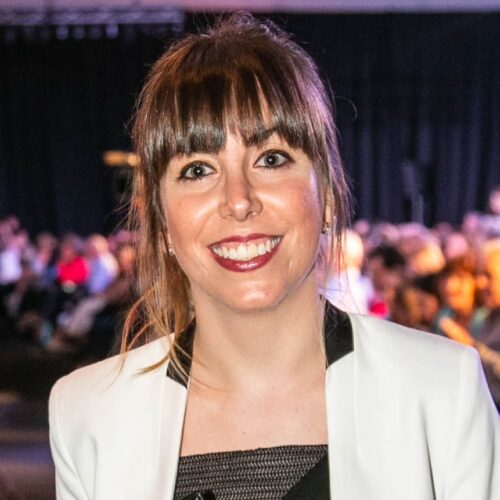Advancing Natural Climate and Community Solutions at COP28
By: Marcela Angel, Research Program Director and Angelica Mayolo, MLK Visiting Scholar
The 2023 United Nations Climate Change Conference (COP28) brought over 84,000 people together in Dubai — representing governments, businesses, civil society, academia, and local communities — to discuss how to move forward with the implementation of The Paris Agreement goals. The attendance was the largest in COP history. Discussions deepened on topics such as the global stocktake, mitigation and adaptation policies, and the operationalization of the loss and damage fund. Despite it being characterized by some media as a quiet COP for the lack of significant announcements from governments and stalled negotiations, the sheer number of delegates and wide array of topics covered in side events testified that climate action continues to gain traction on the ground.
“COPs are moving into an implementation phase, where the big announcements are coming less and less from the negotiators, and more from organizations doing the hard work of implementation and bringing forward new models of collaboration and engagement,” said Marcela Angel, Research Program Director at the ESI.
In an official side event titled “Knowledge to Action: Co-developing Local Solutions to the Climate Crisis,” MIT brought examples of how community-led collaborations between researchers, practitioners, and decision-makers promote knowledge sharing, capacity building, and solutions that are aligned with global environmental challenges and local socio-environmental priorities. Similarly, the ESI’s Natural Climate Solutions Program (NCS) had a robust participation across five pavilions, with over 20 invited speakers and six events, contributing to raising the visibility of technology-enhanced and participatory Natural Climate and Community Solutions. With the participation of community representatives, government officials, multilateral organizations, and researchers, these events were representative of the multi-stakeholder community collaborations needed to foster equitable local climate solutions.
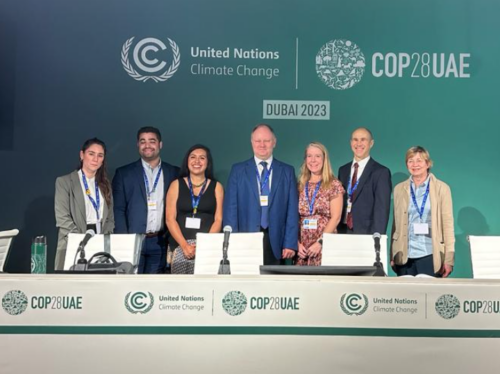
Speakers from the “Knowledge to Action: Co-developing Local Solutions to the Climate Crisis” event gather. From left to right: Marcela Angel, Mark Ortiz, Joice Mendez, Sergey Paltsev, Bethany Patten, Benjamin Zaitchik, and Maria Zuber. Photo credit: Angelica Mayolo
Showcasing the results of a participatory landslide monitoring pilot project
The ESI has been working alongside local partners in the city of Mocoa, Colombia on the challenge of equitable climate change adaptation since 2017, after the city suffered a devastating landslide that caused the death of over 300 people, while injuring and displacing hundreds more. During a side event in the Colombia Pavilion, a team of researchers from MIT, Corpoamazonia, and Pratt Institute — alongside community representatives from the Community Researchers Network, government officials from the Ministry of Environment, and strategic allies from the Development Bank of Latin America CAF and the Global Environmental Facility (GEF) — provided a vision for equitable community-based and technology-enhanced strategies to monitor and respond to climate change. The session showcased the results of the GEF project titled “Drones for Equitable Climate Change Adaptation,” which outlined strategies to combine community-based planning and the development of technological tools for landslide monitoring in Mocoa. Participants were able to engage with the project’s online platform prototype and take part in a lively discussion about the challenges and opportunities presented by the use of new technologies for environmental data collection, and the potential of information coupled with the promotion of community participation to develop risk reduction strategies through nature-based solutions.
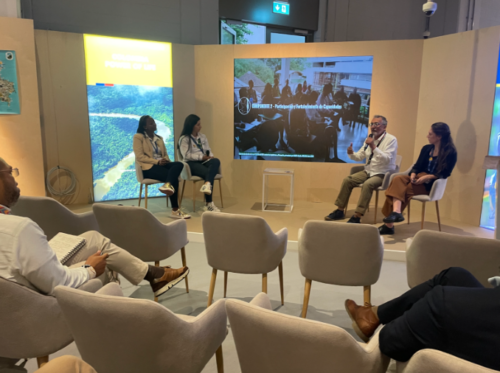
The ESI’s Marcela Angel and local partners present the “Drones for Equitable Climate Change Adaptation” project at the Colombia Pavilion. From left to right: Lucy Castillo, Maritza Garzón, Edgar Torres, and Marcela Angel. Photo credit: Angelica Mayolo
“Civil society worldwide is claiming for collective governance and more diversity in the organizational mechanisms,” said Edgar Torres, a member of the Community Researchers Network. “By being connected to the research from its origin, influencing the project’s mechanism of citizen participation called the Community Researchers Network, and with the objective of bringing in, acknowledging the role, and connecting the community, we are putting forward a model for community-led participation.”
New partnerships for citizen science and biodiversity-based planning
At a side event titled “Indigenous and Afro-Colombian communities’ perspectives for climate action and biodiversity protection: integrating traditional knowledge, culture and local innovation” the ESI, alongside the U.S. Agency for International Development’s (USAID) ACDI/VOCA, Universidad Javeriana, indigenous representatives, and Colombia’s Institute for Scientific Research of the Pacific (IIAP), announced a collaboration to work in partnership with the Humboldt Institute of Colombia to strengthen local capacities in participatory science as a tool for co-creation, democratization, and social appropriation of biodiversity knowledge by various entities, ethnic communities, and local academia in the urban and peri-urban areas of the city of Quibdó.
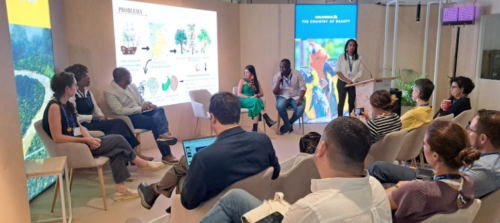
Speakers at the “Indigenous and Afro-Colombian communities’ perspectives for climate action and biodiversity protection” panel convened by ESI and the AIFCC. From left to right: Marcela Angel, Zoraida Quesada, Luis Sevillano, Vanessa Teteye, Pablo Palacios, Angelica Mayolo. Photo credit: Sabrina Monsalve
“Quibdó is located in the Chocó Biogeographic region, within the Tumbes-Chocó-Magdalena global biodiversity hotspot,” said Zoraida Quesada, a researcher at the IIAP. “And it is representative of the development challenges of cities with limited resources and capacities to address the overlapping climate, biodiversity loss, and poverty crisis. Using the bioblitz method, we hope to engage the youth in biodiversity monitoring, aiming to create a baseline of information for the city while transferring technical capacities for the co-creation and appropriation of biodiversity knowledge, empowering local youth in biodiversity protection.”
A research milestone for the Afro-Interamerican Forum on Climate Change (AIFCC)
The panel “Research to action: Insights for conservation from Afro-descendant communities in the Americas,” co-hosted by Conservation International (CI), the ESI, and the Afro-Interamerican Forum on Climate Change (AIFCC) at the Nature Positive Pavilion, showcased the findings of the forthcoming study (led by CI and with co-authors from the other groups) titled, “Recognizing Afro-descendant peoples’ (ADP) role in securing nature in the Americas.” This study, which was framed in the discussions of the AIFCC and headed by CI, a technical ally of the Forum, provides the most compelling evidence to date of the contribution of Afro-descendant people in Brazil, Colombia, Ecuador, and Suriname to biodiversity conservation and climate mitigation.
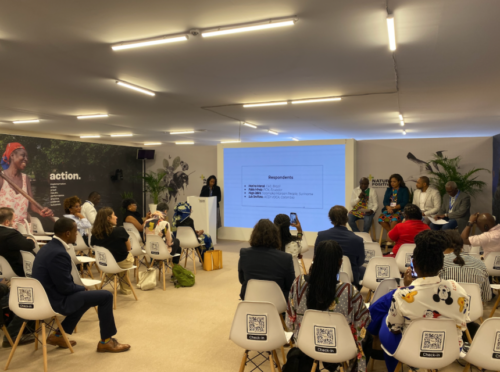
Angelica Mayolo presents the vision for the AIFCC and moderates the “Research to action: Insights for conservation from Afro-descendant communities in the Americas” event with the participation of Hindou O. Ibrahim, Kelvin Alie, Martha Rosero, Hugo Habini, Marina Marcal, Luis Sevillano, and Pablo Minda. Photo credit: Marcela Angel
Martha Rosero, the Social Inclusion Director at CI and a co-author of the paper, presented the study. Then, people responded to the findings with their own perspectives and recommendations. The respondents — representing organizations such as USAID’s ACDI/VOCA, Universidad Javeriana, C40 Brazil, the Saramaka Community of Suriname, and Universidad Tecnica Luis Vargas Torres of Ecuador — represented four countries and organizations from academia, NGOs, community leaders, and international cooperation working towards the conceptualization and launch of the AIFCC Researcher Network, which aims to promote a collaborative research agenda focused on addressing research gaps to advance policies and local priorities of ADP related to biodiversity and climate.
Discussing transnational priorities for the Grand Chocó region
In a conversation convened and facilitated by the ESI and the Development Bank of Latin America CAF at the Latin America Pavilion, Sebastian Carranza and Ligia Castro — the Climate Change Directors of the Ministries of Environment of Colombia and Panama — led an in-depth discussion about the pressing threats and challenges with regard to the sustainable development and conservation of the Chocó Biogeographic Region and the need for instruments to strengthen collaborative work and enable joint international efforts for the conservation of this region. Ignacio Lorenzo, Technical Director for Climate Action and Positive Biodiversity at CAF, shared CAF’s perspective on the effective ways in which governments can implement coordinated conservation efforts.
The side event, which was titled “The Chocó Biogeographic Region: Urgent call for a transnational effort to protect biodiversity,” also featured the work of Javeriana Professor Pablo Palacios and the MIT ESI’s MLK Visiting Scholar Angelica Mayolo, who presented an overview of the current demographic, economic, and environmental challenges of the Biogeographic Chocó (which is also referred by the researchers as the Grand Chocó region).
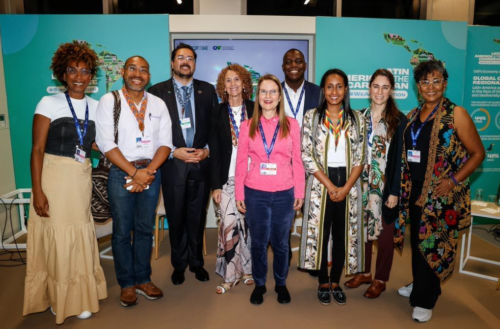
Speakers from “The Chocó Biogeographic Region: Urgent call for a transnational effort to protect biodiversity” event gather. From left to right: Zoraida Quesada, Luis Sevillano, Ignacio Lorenzo, Alicia Montalvo, Ligia Castro, Pablo Palacios, Angelica Mayolo, Marcela Angel, and Martha Rosero. Photo credit: CAF
“The Grand Chocó region has lost around 10% of the local species of birds, 16% of all species of mammals, and 39% of amphibians,” explained Palacios, referring to the biodiversity loss trends in the region. “With a quarter of all species being endemic to the region, the damage to local biodiversity puts the entire ecosystem at risk”
Mayolo reinforced those figures in her closing remarks.
“The biggest challenges faced by the Biogeographic Chocó are all international threats, therefore requiring international action to ensure the protection of the region,” she said.
The ESI appreciates the support and commitment of multiple partners who contributed efforts and resources for the successful realization of these events and the wide participation of members from local communities, including GEF, CAF, USAID ACDI/VOCA, Pratt Institute, MIT´s MLK Program, the BMW Foundation, Universidad Javeriana, CI, and MISTI.
Three Questions on Carbon Markets with Jimena Muzio
Before Jimena Muzio officially joined the ESI as a research associate this August, she was a student in a “Biodiversity and Cities” course that was co-instructed by ESI Director John Fernández during the Spring 2022 and 2023 semesters. She also served as an ESI Summer Fellow in 2023, where she traveled to Colombia to work on a Spanish report that aimed to provide urban development strategies to promote biodiversity conservation in the city of Quibdo and its surrounding areas. These findings were presented to national and local government authorities, research institutions, and civil society organizations.
Currently, she is working on a research project focused on understanding the involvement of ethnic communities in the Colombian carbon market and its impact on advancing sustainable development goals and promoting climate justice.
To introduce Jimena, we asked her three questions about her work with carbon markets.
How have you applied what you’ve learned from your range of pre-ESI experiences — from working in Argentina’s non-profit and government sectors to serving as a research assistant at the MIT Center for Real Estate — to your research at the ESI?
My professional experience before coming to MIT, both at the non-profit and government sectors, taught me two important concepts when dealing with complex problems, particularly in the realm of governance and policy-making: resilience and robustness in analysis.
Resilience in policy making is about creating policies and governance systems that can withstand shocks, adapt to changing circumstances, and continue to fulfill their objectives in the face of uncertainty. This becomes crucial when thinking about climate change and environmental challenges.
Similarly, I learnt that robust analyses are a crucial component of designing policies. By conducting a robust analysis, policymakers can enhance the quality of decision-making, improve the likelihood of successful policy outcomes, and build public trust through evidence-based and transparent practices.
What is something that you think everyone should know about carbon markets?
One of my main takeaways of NYC Climate Week 2023 is that carbon markets alone cannot resolve the climate crisis, but they can indeed make a substantial contribution to them, provided the primary focus remains on decarbonizing our economy. In this sense, given the considerable costs associated with decarbonizing operations, ensuring the alignment between science and the real economy is imperative. Otherwise, companies will not invest in these efforts unless they can break even. This raises the question of what measures the public sector can take to provide the right incentives and support for decarbonizing real economy sectors.
What excites you most about your research moving forward?
I’m really excited about the future prospects of carbon markets projects with ethnic communities and the possibility of contributing to enhancing their potential to uplift and benefit these communities. I believe that by refining and improving their transparency, carbon markets can be effective mechanisms for biodiversity conservation and carbon emissions reductions while, at the same time, fostering equitable development.
To learn more about Jimena’s research, you can contact her at mjmuzio@mit.edu.
Creating Climate Art as a Participatory Design Research Method
By: Sara Laura Wilson, Research Assistant
Designing for sustainable behavior change is more than a technological challenge; it’s a human one. Each of us brings a complex tapestry of attitudes, beliefs, and associations to our interactions with designed products and services, which invariably color our receptivity. For instance, a hopeful or hopeless attitude towards climate change greatly influences our engagement in sustainable behaviors. When interacting with products or services designed for sustainable behavior change, we are not merely responding to the design elements in isolation – we are also engaging with our deeply entrenched associations with the broader issues of climate change.
To understand the human perspective of sustainable design, Sara Laura Wilson, a research assistant in the Environmental Solutions Initiative (ESI), is looking into the intersection of climate identities and design for pro-environmental behaviors, like energy conservation, waste management, and environmental protection. Together with ESI research associate Supreetha Krishnan and their cohort of UROPs — Bianca Lee, Zainab Khan, and Simon Opsahl — they hosted a Climate Art Night on Nov. 14. The event was a research workshop that doubled as a social gathering. It drew 40 participants from the MIT community who each created an art piece that reflected their relationship with and attitudes towards the environment, collaged with their choice of assorted magazines, newspapers, construction paper, crayons, and paint pens. Upon completing their piece, participants wrote an artist statement to accompany their creation and provide further insight into their artistic process and mindset.
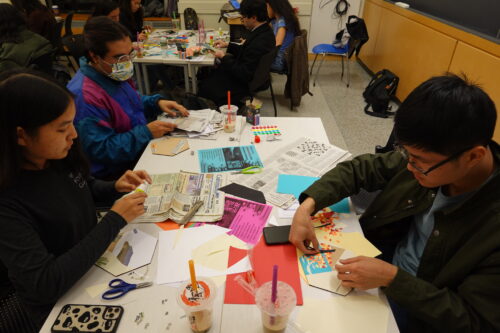
MIT students created art pieces that reflected their relationship with and attitudes towards the environment at the Climate Art Night on Nov. 14. Photo credit: Bianca Lee
This workshop is part of an ongoing series of events that are tailored to understanding user perception on climate change and environmentalism through fun and interactive means. It was first conducted as part of the MIT Climate Machine’s collaboration at the 2023 Group Therapy Weekender, an electronic music festival at the Gorge Amphitheater in Washington state. There, 30 festival attendees created climate art pieces that were displayed as a collective art piece at the festival.
Climate art gives insight into the emotional and visual associations people have with the environment; it can also serve as valuable user input for early-stage design development. The integration of user input in the early stages of product and service design is a critical component in developing effective tools that promote pro-environmental behavior. Engaging with users during the formative phase of design not only enhances the overall acceptability of the product but also significantly lowers the risk of product abandonment due to design-user misalignment.
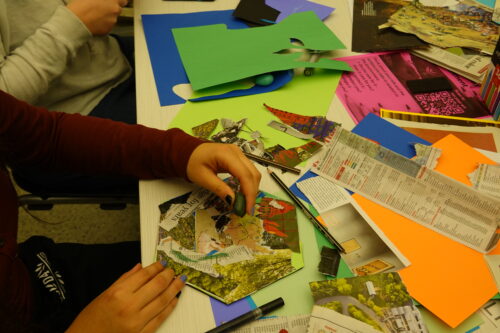
The Climate Art workshop, conducted as a participatory design research method, was developed to understand the visual, verbal, and emotional associations each participant has with the environment. Photo credit: Bianca Lee
Insights from these workshops will be integral to the research group’s development of eco-feedback mechanisms for product design. Eco-feedback design, which encompasses quantitative displays (such as the number of resources consumed or saved) and figurative representations (such as visual metaphors that convey environmental impact), stands out for its effectiveness in promoting environmental stewardship. Through workshops like this, the researchers aim to understand the pre-existing visual and emotional associations users have with the environment, and thereby effectively design figurative representations for eco-feedback that encourage behavior change.
The challenge, and the opportunity for sustainable behavior design innovation, lies in designing mechanisms that not only convey information effectively but also inspire a long-term commitment to pro-environmental behavior. Such designs must therefore be user-centric, involving users in the developmental stages to ensure that the final product aligns with their values, beliefs, and emotional landscape. Through continued workshops within the MIT community and beyond, the research group’s goal is to create a product experience that, through strategic information delivery and emotional engagement, perpetuates sustainable behavior beyond the point of direct interaction with the product itself.
Results and analyses from this event and the Group Therapy Weekender will be examined in a forthcoming research publication, expected in Spring 2024.
Cyclone-Like Technology Holds Promise in Creating a Circular Economy for Small Plastics
By: Sophia Apteker, Administrative and Communications Assistant
For Alexis Hocken, a third-year PhD student in the Department of Chemical Engineering at MIT, conversations at the Packaging Recycling Summit revolved around a singular question: How can people — at all links of the circular supply chain — bridge the communicative gap between brands who are designing plastic packaging and material recovery facilities (MRFs) that are recycling them?
Hocken works specifically with small-format plastics, or items that are less than two inches long in at least two dimensions. (Think: travel-sized containers, cosmetic packaging, or other consumer product goods.) When it comes to her research, the disconnect occurs when these products are sent to a MRF to be recycled, but their tiny size causes them to slip through a mesh screen, which was intended to filter out glass shards.
“It results in this glass stream that’s riddled with a lot of these valuable small formats that could be recycled and ultimately are not getting recycled,” Hocken said.
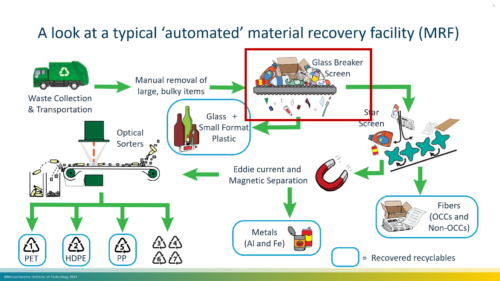
At a typical MRF, small-format plastics slip through a mesh glass breaker screen early on in the recycling process. Photo courtesy of Alexis Hocken
To get these plastics to the end of the recycling line, a coalition of consumer product companies — including Colgate-Palmolive, Procter & Gamble, the Estée Lauder Companies, L’Oreal, and Haleon — have partnered with Hocken and her team in Prof. Brad Olsen’s lab to develop solutions. The lab also works in collaboration with Desirée Plata, an associate professor of civil and environmental engineering; the MIT Environmental Solutions Initiative; and The Sustainability Consortium.
At the Summit, Hocken spoke on a panel titled “Making the Case for Small-Format Packaging Recycling.” She was joined by Jennifer Park, the Director of Engagement at The Sustainability Consortium, and Ana Espinosa, the Packaging Sustainability Manager at ELC Management llc. Approximately 300 people were in attendance, either in person or virtually.
Park opened with a few notes on why eliminating small-format plastics, or just making them bigger, is not a sustainable solution. Most importantly, many small plastics are small for a reason: they maintain the utility of the object. (“You wouldn’t want, or be able to use, a giant Chapstick tube or contact lens case,” she said.) This presents a problem to a slew of companies, specifically those within the cosmetics industry, that have portfolios dominated by small-format plastics.
Because if the plastics’ size can’t be altered, then what?
Espinosa pointed to innovation within the current recycling streams and processes, a space where Hocken was able to step in. She presented her lab’s proposed solution: a secondary cyclone-like screening process.
“It’s like a density-based separation where we can capitalize on the stark density differential between plastic and glass,” Hocken said of the technology. “It results in these two theoretically pure streams: one glass and one of small format plastics. These plastics can then be recovered and used in new products and packaging.”
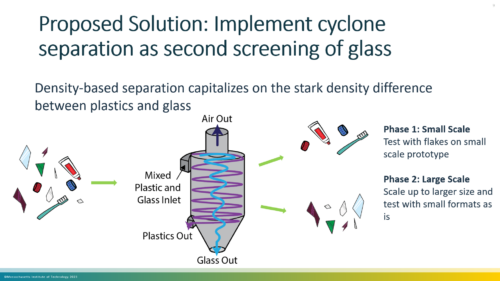
A secondary screen would be able to separate the plastic and glass that fell through the glass breaker screen. Photo courtesy of Alexis Hocken
“So we have this mixed plastic and glass inlet that’s fed through into this cyclone,” Hocken said in her presentation. “Basically, you have this circular air profile that’s present, and so your lighter plastics will be able to stay suspended within this air profile long enough to be able to access out this side outlet. Whereas your glass, this denser, heavier material, would be relatively unaffected by this air profile and just fall out the bottom.”
Since there isn’t a lot of data available on the amount of these small format plastics that are actually making it into these recovery facilities, The Summit was useful in connecting those working on this project, especially within The Sustainability Consortium, to industry leaders with resources that could assist them in furthering their research. The conference also helped garner a more well-rounded perspective regarding the cyclone’s feasibility, especially from those at MRFs.
Looking ahead, the cyclone’s results are promising. Hocken and her team ran a techno-economic assessment (TEA) and calculated its global warming potential (GWP) to determine if its implementation would be beneficial from economic and environmental standpoints. The cyclone checked both boxes.
Recently, the team has filed a patent with the MIT Technology Licensing Office.
“We’ve seen really effective separations already within this smaller prototype,” Hocken said. “We’re excited to keep digging and keep pushing this technology to be more similar to what you would see in a realistic environment, that is, a waste recovery facility, and see how it performs in those more challenging or intense circumstances.”
To view the full presentation and slides, you can make a free account on the Packaging World website.
The ESI’s Rob Fetell Wins Best Poster at First MIT Energy & Climate Night
By: Sophia Apteker, Administrative and Communications Assistant
For 18 years, there was an annual MIT Energy Night. This year, for the first time, there was MIT Energy & Climate Night.
It was natural for the hosting MIT Energy & Climate Club (known as the MIT Energy Club before fall 2021) to weave climate into their flagship event. They have been delving into climate-conscious conversations at the leadership level for the past couple of years, something sparked by a trend in climate tech poster proposals first observed in 2019. Then, in 2020, the club began turning down fossil fuel funding to make its sponsorship money cleaner.
The name shift didn’t inherently change the makeup of the club or this event. It better reflected them.
“The kind of people who were interested in joining our club were both interested in energy and climate,” said Aaliya Hussain, a third-year MIT student who is one of MIT Energy & Climate Night’s managing directors. “We mainly rebranded to make it more inclusive and also cover the scope of what energy actually looks like today, which is a lot different than it looked like years ago.”
This transition was able to more obviously open the door to researchers like the ESI’s Rob Fetell to share their environmentally-focused findings.
Fetell’s presentation, titled “Engineering Evaluation of Satellite InSAR for Mine Tailings Dam Resilience and Early Warning Systems,” was awarded first place by attendee vote. The voting process was something that was also new this year, designed to give more of an active role to those passing through. A green ticket was given to each attendee at the door to vote for their favorite poster.
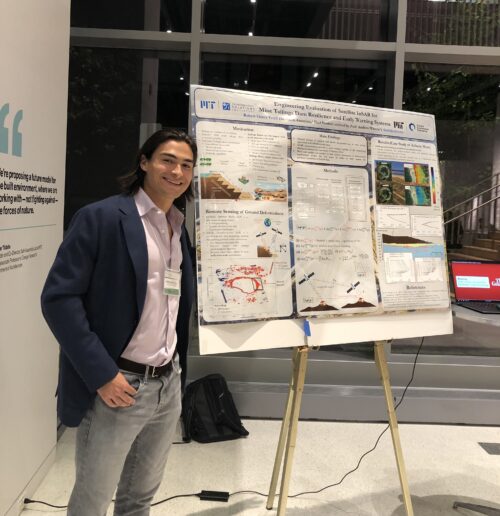
Rob Fetell with his first place poster. Photo credit: Sophia Apteker
His presentation explored how remote sensing can be used to improve transparency and safety in the mining industry. Currently, 18.3% of active upstream tailings dams report notable stability concerns, or a failure to confirm or certify stability at some point in their history, and the increasing frequency and severity of failure events is expected to continue. The primary technologies used, like embedded sensors (inclinometers, extensometers, and piezometers), are oftentimes unable to catch these failures. By providing 24-hour advance notice before a tailings dam failure — which Fetell’s InSAR technology hopes to do — it’s possible to reduce losses caused by these failures by as much as 30%. The same report also noted that a global investment of $800 million in early warning systems could prevent annual losses of $3 billion to $16 billion globally.
“It felt awesome to get the first place award,” said Fetell. “I have to admit, I was nervous at first, but every time I presented to a new group that came by, I could sense that my message was getting tighter and more engaging.”
Fetell was also particularly appreciative of his collaborators, including Alfredo Rocca at EO59 and Gonzalo Corral at Inteligencia Geotechnica, who guided him with SARProz post-processing software to understand the physics behind InSAR technology.
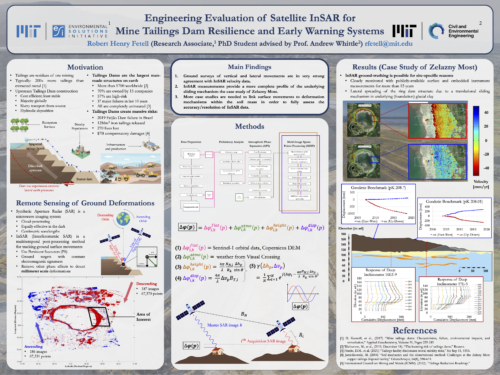
A close-up of Rob Fetell’s poster, courtesy of Rob Fetell, which can also be found here.
The night was studded with three keynote talks, 35 presenters, and upwards of 450 attendees.
Many of these attendees were MIT undergraduate and graduate students, but there were also a mix of individuals from universities in the Cambridge and Boston area, including Harvard, Northeastern, and BU. Eight students from The University of Texas at Austin also presented, tied to MIT through the Martin Trust Center.
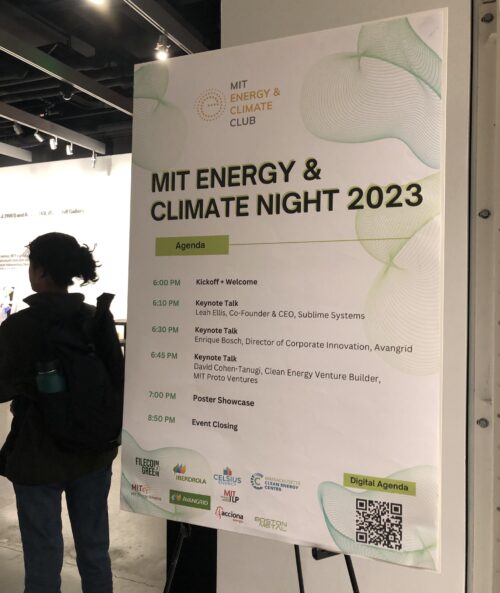
MIT Energy & Climate Night featured three keynote talks and a poster showcase. Photo credit: Sophia Apteker
When it came to the event’s layout, the presentation topics were deliberately not sorted by sector.
“We wanted to have a random walk effect and encourage people to explore different areas of the space and demonstrate that in climate, in general, there aren’t distinct subgroups within the space,” said Hussain. “It’s not a solute environment inherently, and it should not be one.”
Other poster highlights included a system that used wall outlets to charge EVs, a multiple-occupancy solar electric vehicle, and a wind powered desalination system.
The event was coordinated by 11 MIT Energy & Climate Club members who were supported by the club’s co-presidents, as well as their finance, sponsorship, and marketing teams. The club has approximately 600 total members who are undergraduate, graduate, PhD, and MBA students.
“We have every department, and people come from different backgrounds,” said Shreyaa Raghavan, a PhD student who is one of the club’s co-presidents. “I myself am a computer science student, but we have people who are more business-oriented, more policy-oriented, more engineering or computer science oriented. I think that’s what makes this a unique space in terms of what kind of perspectives you can get from energy and climate.”
From Nov. 10-12, there will be the MIT Energy & Climate Hackathon. Like the Energy Night turned Energy & Climate Night, this hack will be the first climate-inclusive one of its kind.
“We have positioned ourselves as a hub on campus for energy and climate,” said Raghavan. “My main hope is that we continue that, and just grow bigger in terms of who we attract. I think that there are a lot of people who are interested in energy and climate broadly, even in their personal day-to-day life…but they think that it’s too niche of a club or you have to be ‘all in energy’ or you can’t join. I’d really like to make it an inclusive community for anyone who is even slightly interested in energy and climate, and help them find resources to push them in that direction.”
Learn more about Rob Fetell or the MIT Energy & Climate Club.
The ESI Launches the Climate Justice Instructional Toolkit
By: Sophia Apteker, Administrative and Communications Assistant
Even though the demand for climate solutions is ever-pressing and ever-present, research has shown that there is a lack of climate justice education in STEM fields. And how can scientists start developing solutions to a problem that they’re not even informed of?
Enter: the ESI’s Climate Justice Instructional Toolkit, a collection of resources for students and educators that gets climate conversations rolling in bite-sized, easily adaptable modules.
The Toolkit aligns with Fast Forward: MIT’s Plan for the Decade, published in the spring of 2021, that acknowledged MIT’s need to bolster its climate education offerings and committed itself to net-zero carbon emissions by 2050. More specifically, the Toolkit reinforces the section of the plan titled The Imperative of Justice that noted that to achieve those goals, “it must do so fairly.”
That means understanding that low-income and BIPOC communities have been disproportionately affected by climate change, even though they are the least responsible for it. Furthermore, the plan states that, “the world will not solve the climate problem without solving the intertwined problems of equity and economic transition.” These kinds of topics, the ones that directly address the inequitable causes and impacts of climate change, are foundational to the Toolkit.
Toolkit contents
The Toolkit consists of a a starter guide for teaching climate and environmental justice, resources for students, climate justice data sets, and 12 adaptable teaching modules. There will also be a Teaching Climate Justice Across the Curriculum workshop series during the 2023-2024 academic year.
The modules, which are foundational and discipline-specific, include:
Foundational Climate and Environmental Justice Modules
- Introduction to Climate Justice
- Climate Justice Policy
- Global Climate Justice
- The Just Transition
- Indigenous Climate Action
- Mapping Environmental Justice
- Mining and Climate Justice Case Studies
- The Emotions of Climate Justice
- Energy Justice
Discipline-Specific Modules
- Engineering Climate Justice
- Climate Justice in Biology, Exposure Science, and Epidemiology
- Climate Justice for Inclusive STEM Research and Communication
Accompanying instructor guides can be found here.
In each module, there are learning objectives and an agenda, foundational resources (like videos or readings), lecture material and notes, and project and assignment options.
The ESI is looking to expand into more discipline-specific modules in the future.
For student and educator use
The Toolkit is intended to be integrated into undergraduate introductory courses, specifically in disciplines related to sustainability and environmental education. But they don’t have to be plugged verbatim. Instead, they can be adapted to fit certain subject areas.
For example, Nuclear Science and Engineering Professor Haruko Wainwright, who worked with ESI postdoctoral associate Chris Rabe to review and pilot the Engineering Climate Justice module, will use various materials from that resource in a new lecture this semester that centers climate justice as a guiding principle for engineering. In addition, Basuhi Ravi, a PhD candidate in Materials Science and Engineering, used slides from the Introduction to Climate Justice module while teaching an experiential sustainability course this past summer. Both of these instructors reviewed the modules and selected relevant slides and resources that met the needs of their specific teaching contexts.
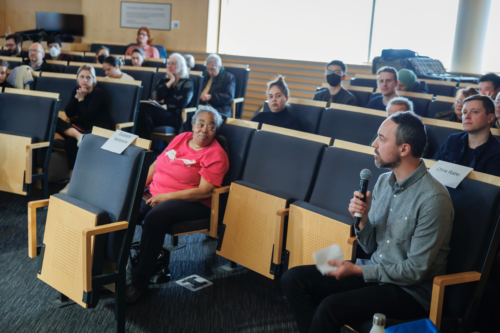
Chris Rabe (ESI postdoctoral associate) responds to a question from Bettina Stoetzer (MIT Associate Professor of Anthropology) during the Climate Justice Launch event in April. Photo credit: Tim Correira
The Toolkit’s flexibility also lends itself to be given to collegiate students as a resource to self-study, to be adapted for high school students, or to be used for the professional development of staff and administrators. At the very least, the Toolkit can be used to spark discussions, to plant a seed.
Toolkit builders
The Toolkit was funded by the Alumni Class Funds Grant and crafted by a six-person team of students and ESI staff who have been working on the project since June 2023.
Several of these students were part of the ESI’s Rapid Response Group (RRG), which aims to respond to critical environmental issues in a timely manner with science-based analysis and assistance in the service of their partners in communities, civil society, government, and industry. Since the Toolkit’s resources were co-constructed with students, who are the Toolkit’s primary audience, the ESI was able to integrate valuable undergraduate perspectives into its lessons and activities.
Toolkit builders include: Chris Rabe (ESI postdoctoral associate), Madison York (Northeastern University co-op student), Rachel Carethers (Wellesley College RRG student), Amberley Yang (Wellesley College RRG student), Bethany Costanzo (Northeastern University UROP student), and Sylvia Scharf (ESI climate education specialist).
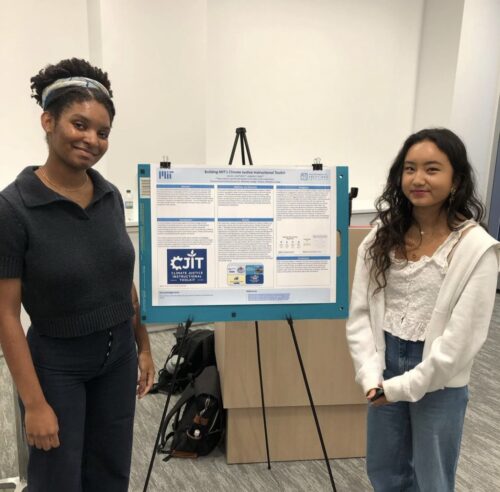
RRG students Rachel Carethers and Amberly Yang presented their research at the RRG showcase at the MIT Museum in September. Photo credit: Sophia Apteker
“There is a pressing need to integrate the voices, knowledge, and experiences of those most impacted by climate change into the curriculum,” said Rabe. “The goal of the Climate Justice Instructional Toolkit is to spur more cross-disciplinary climate justice teaching and learning by providing resources, examples, and instructional guidance to a general audience.”
Have you explored or used our climate justice resources? Fill out this form or contact Chris Rabe at cjrabe@mit.edu to tell us more about your experience.
RRG Showcase Displays Student Solutions for Pressing Environmental Challenges
By: Norhan Bayomi, Postdoctoral Associate
The MIT Museum was buzzing with excitement on the evening of Sept. 13 as 20 Rapid Response Group (RRG) students presented their summer research projects that tackled urgent environmental issues facing the world today. The RRG is a program within MIT’s Environmental Solutions Initiative (ESI) that recruits undergraduate and graduate students to quickly respond to pressing environmental issues that are faced by communities, governments, industries, and civil society. They develop science-based solutions and produce diverse materials useful to external partners — like fact sheets, review papers, executive summaries, and briefing documents — across a wide range of environmental topics.
This summer’s cohort was the fifth since the RRG’s inception, which was in the summer of 2020. Program alumni now total over 100 MIT students, with a few from Wellesley College and other universities.
Students participated in the RRG this past summer came from various programs and majors at MIT and Wellesley, working under various ESI research programs, such as Natural Climate and Community Solutions, Cities and Climate, Climate Justice, Education, Mining and the Circular Economy, and Arts, AI, and Climate. Their projects aimed to provide analysis, recommendations, and science-based reviews of the environmental challenges examined in these programs. Students worked in small groups, with research leads from the ESI staff serving as mentors and managers of each project.
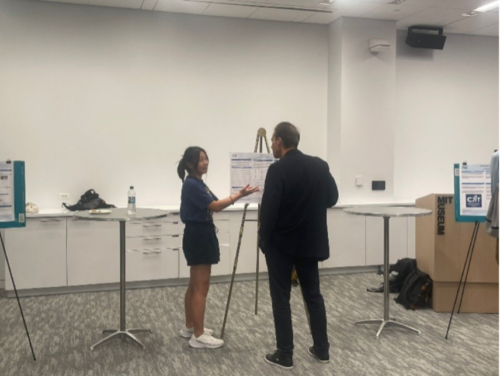
Kelly Hong, a first-year Course 6 student at MIT, presented her project on generative AI-Art during the poster session. Photo credit: Supreetha Krishnan
“The Rapid Response Group enables us to serve needs beyond the MIT campus while implementing a real-world learning by doing on environmental challenges, from decarbonization through next generation heat pumps to an examination of emerging climate injustice,” said Professor John E. Fernandez, Director of the ESI. “By offering engagement opportunities with government, companies, communities, and civil society, students learn how messy the world is and how time consuming and difficult, but possible, it is to effect real change.”
The event kicked off with students presenting their research projects during a poster session and fielding questions from attendees. For most, if not all of the undergraduate members of the RRG, this was their first time creating a poster and participating in a poster session. Topics included analyzing urban policy landscape in 9,000 urban centers globally, mapping urban susceptibility to landslides using drones in Colombia, establishing the current trends in deployment of heat pumps, and exploring the next generation of important decarbonization technology.
Simon Opsahl, a third-year Course 6 student at MIT, worked on a project under the Climate Machine — a research group under the Arts, AI, and Climate research program. He hosted a climate engagement workshop during The Group Therapy Weekender at the Gorge Amphitheater in Washington that involved getting attendees to create physical art that reflected their views about the planet and environment.
“Flexibility is key in fieldwork,” said Opsahl, when reflecting on his project. “A lot of people at the festival [were] really passionate about protecting our world, and the care they took in their art [was] reflective of such.”
Sara Wilson, a second-year Ph.D. student in human-centered design research for sustainable development, reflected on her own experience managing the RRG during the summer.
“It [was] inspiring to be surrounded by a group of undergraduates across a variety of disciplines — from cognitive science to mechanical engineering to computer science — who were drawn to join the Rapid Response Group by their shared desire to gain hands-on, interdisciplinary experience in sustainable development,” Wilson said. “Working with [the students] reaffirmed my conviction in the necessity of interdisciplinary teams in environmentalism and sustainable development.”
Following the poster session, ESI Director John E. Fernandez gave brief introductory remarks on how the RRG program helps to bridge ongoing ESI research teams and the MIT undergraduate community.
The evening then segued into lighting talks, where seven groups of two to three students briefly summarized their work with a supporting PowerPoint slide. The talks highlighted several topics, including: creating an AI pipeline to map Chagras in Colombia, supporting climate conversations with indigenous communities in Washington, developing a climate justice toolkit for educators, and developing immersive a virtual reality exhibition to enrich public engagement in climate action.
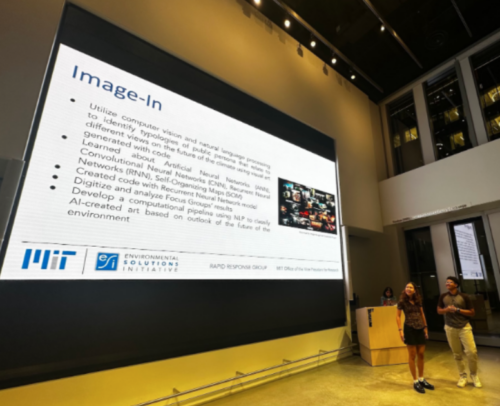
Bianca Lee, a fourth-year Environmental Studies and Economics student at Wellesley, and Dylan Mazard, a third-year Course 6 student at MIT, presented their work related to Arts, AI, and Climate during their lightning talk. Photo credit: Norhan Bayomi
The RRG showcase provided a snapshot of the next generation of environmental problem solvers who are working on real solutions at MIT. The rapid-fire format of the lighting talk gave the students valuable experience in communicating their work quickly and concisely to a general audience. This event was an inspiring demonstration of students’ passion for progress, something matched only by their brilliance.
As one attendee reflected, “The evening was a testament to how MIT continues leading research and innovation to help create a just and sustainable world.” The greatest achievement of the RRG is that its members personify this spirit of knowledge in the service of humanity.
Click here to learn more about the Rapid Response Group.
A Reflection of Climate Week NYC
By: Marcela Angel, Research Program Director; Angelica Mayolo, MLK Visiting Scholar; Jimena Muzio, Research Associate; and John E. Fernandez, Director
From September 17-24, four members of the ESI — Marcela Angel, Angelica Mayolo, Jimena Muzio, and John E. Fernandez — attended Climate Week NYC. The event is the largest annual climate event of its kind, bringing together some 400 events and activities across the City of New York.
The ESI was particularly involved in events related to climate justice and voluntary carbon markets.
Climate Justice in the Americas
Members of the ESI joined forces with the Climate Justice Innovation Lab, a space where leaders from across the Americas came together to explore the root causes and dimensions of climate injustice, map current gaps and opportunities, and work to create solutions towards a fairer and more sustainable future.
In collaboration with the BMW Foundation, Climate Ventures, and MIT Solve, the ESI co-organized a dynamic and interactive session focused on exploring synergies, identifying gaps, and sharing experiences and solutions centered around climate justice. The session, called Climate Justice Insight Session, convened experts and community leaders working in areas affected by climate change and created a space to exchange perspectives across sectors, including: investors, grassroots organizations, philanthropy, activists, civil society, and academia.
The session included a panel discussion, brainstorming session, and break-out groups on knowledge co-creation, historical reparations, leadership and capacity building, and finance, among others, and showcased the work of the ESI´s Natural Climate Solutions Program, which includes mapping the presence and overlap of Afro-descendant communities in the Americas and strategic ecosystems.
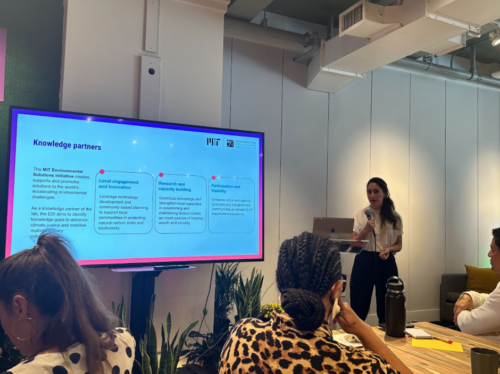
Marcela Angel presents the Natural Climate Solutions (NCS) Program approach at the Climate Justice Insight Session. Photo credit: Angelica Mayolo
The ESI’s MLK Visiting Scholar, Angelica Mayolo, participated in a panel titled “The Urgency of Climate Justice,” which was moderated by Brazilian climate journalist Andreia Couthino and Dominique Souris from Climate Justice-Just Transition Donor Collaborative. In this space, the panelists highlighted the importance of joint and multi-sector efforts to promote climate justice actions.
Mayolo pointed out that to advance climate justice in Latin America, it is necessary to advance collective titling and property rights for ethnic communities, create new financing mechanisms for local communities to implement natural climate solutions and the development of green businesses, strengthen institutional capacities of local governments for climate action, and promote the conservation of ancestral knowledge related to environmental protection.

Panelists discuss. From left to right: Dominique Souris, Andreia Coutinho and Angelica Mayolo. Photo credit: Marcela Angel
“As a thought partner of the Climate Justice Innovation Lab, our aim is to help identify critical knowledge gaps that are based on the needs of local communities,” said Marcela Angel, Research Program Director at ESI. She continued, saying the ESI’s responsibilities extend, “in service of a public policy agenda, [to] help mobilize the academic community at MIT and beyond, and to foster knowledge co-creation that can help inform policies or help create solutions that address the interconnected crises of climate change, biodiversity loss, and social inequality.”
This session of NYC Climate Week was particularly relevant to MIT’s commitments to climate change as articulated in Fast Forward: MIT’s Climate Action Plan for the Decade. In that plan, the Imperative of Justice section articulates the importance of addressing development and living standards alongside decarbonization in the developing regions of the world.
“The critical need for technology development and real breakthroughs cannot overshadow the importance of anticipating intensified inequities and novel climate injustices,” said ESI Director John E. Fernandez. “Our work in climate justice includes the reasoned and science-based understanding of the coming threats to vulnerable communities. A world of low carbon energy and net zero emissions is not, by default, a more just world. We have to make sure the technologies we deploy are done such that justice, in its various forms, is enhanced. I’m thrilled that the ESI is focused on these issues through the Natural Climate Solutions Program and the Climate Justice Program in partnership with the Climate Justice Innovation Lab.”
Voluntary Carbon Markets
ESI’s Research Associate, Jimena Muzio, participated in the Carbon Smart Summit, where leading policymakers and prominent industry experts convened to unlock the transformative potential of voluntary carbon markets. The summit delved into several key themes, including corporate engagement in carbon markets and the necessary prerequisites for stimulating demand, challenges related to project financing, and the role of technology in enhancing market efficiency and integrity. Additionally, the event provided an overview of the latest policy updates that could impact the future of carbon markets.
Throughout the summit, there was a recurring theme that emphasized how inaccurate the idea of choosing either carbon removal or carbon avoidance projects as a path to net zero is. Both types are essential components if we are to achieve decarbonization. While it is acknowledged that avoidance projects face increased scrutiny regarding their actual impact, emerging technologies — such as artificial intelligence and remote sensing — hold promise in significantly enhancing monitoring and verification processes, thereby increasing transparency and bolstering market confidence.
Another point of unanimous concern among panelists was that the voluntary carbon market should not be seen as a substitute for decarbonization efforts. Companies are urged to exhaust all possibilities in reducing their operational carbon emissions and then resort to purchasing carbon credits to offset any residual emissions post-decarbonization.
Furthermore, the consensus at the summit underscored the nascent nature of carbon markets. Despite their current shortcomings, the agreement was that eliminating them was not the solution. Instead, there is an urgent need to enhance regulation and standardization to heighten transparency and instill confidence in buyers. The heterogeneity in carbon market regulations and credit prices currently impedes the scaling-up of the market to the necessary extent. Additionally, there is a growing imperative to develop better tools for accounting for co-benefits, such as biodiversity conservation.
Finally, Muzio highlighted that while carbon markets alone cannot resolve the climate crisis, they can indeed make a substantial contribution, provided the primary focus remains on decarbonizing our economy. In this sense, given the considerable costs associated with decarbonizing operations, ensuring the alignment between science and the real economy is imperative. Otherwise, companies will not invest in these efforts unless they can break even. This raises the question of what measures the public sector can take to provide the right incentives and support for decarbonizing real economy sectors.
Now back in Cambridge, the ESI team is both eager and committed to continue working on climate justice and voluntary carbon markets. These are areas that require attention and urgent action, and we will continue to identify new allies as we work towards our goals.
Click here to learn more about Climate Week NYC.
Rob Fetell Joins ESI as a Research Assistant for the Program on Mining and the Circular Economy
By: Sophia Apteker, Administrative and Communications Assistant
Career defining moments happen when you least expect them. For Robert Fetell, that moment occurred in his very first class on his very first day as a PhD student at MIT, when Civil and Environmental Engineering Professor Andrew Whittle closed his class with a video of the 2019 Vale S.A. mine tailings dam collapse in Brumadinho, Brazil.
The video showed the slow-motion release of 11.7 square cubic meters of mine tailings, or waste, from the collapsed dam, which reached the Paraopeba River, five miles away. The rapid flow of muddy waste devastated the Brazilian region, killing 270 people and destroying farmland central to an agricultural economy.
That video ignited Fetell’s concern for the future of mining host communities and his interest in the life-saving value of early warning systems, which did not go off at the Vale dam.
“I began to realize the scale of the problem we are dealing with,” Fetell recounted. “Tailings dams are among the largest man-made structures on earth, and they will keep getting bigger as our global appetite for minerals continues to grow.”
“This places a lot of downstream communities in harm’s way, primarily in the Global South,” Fetell continued.” Recognizing the dire need for early warning systems, he set out to harness the power of satellites with his research.
Fetell is currently working on using publicly available remote sensing data to monitor the safety and stability of tailings dams, to catch risks and anomalies that would indicate impending failure. This would encourage communication between mining companies and communities.
“People have a right to know if they are in danger,” Fetell said. “The idea is to alert people that they need to evacuate in the same way we do when a hurricane is coming.”
And since Fetell originally came to MIT to study coastal resilience, he is familiar with hurricanes. His new focus on mine tailings — and the decision to join ESI as a research assistant for the Program on Mining and the Circular Economy — may seem like a major career pivot, but it’s actually quite consistent with his passion for resilience.
Early Ties to the Environment
As a native of Miami Beach, Fetell has had firsthand experience with disasters from a young age. At six years old, he woke up to dead fish flopping on his lawn. It was a result of Hurricane Wilma, which caused Biscayne Bay to overtop a nearby seawall.
“Our neighborhood was blanketed in debris, which raised a lot of questions for me,” Fetell said. “How did the water get to where it was? Why were some houses untouched while others were unlivable? It was just a genuine interest in how things worked that shaped most of my thinking.”
Years later, this interest in natural processes and their impacts would lead him to earn both an MS in Engineering Geology and a BA in Geology from the University of Pennsylvania. A passionate believer that young people deserve a bigger voice in the way our communities adapt to climate change, he also founded the Resilience Youth Network (RYN): a 501(c)(3) that hosts speaker-networking events and runs an annual fellowship program for high school and early college students to develop the next generation of climate resilience leaders.
After all, a major theme of resilience is preparation. To Fetell, early warning systems are the perfect way to bridge environmental advocacy with his technical research.
Translational Research to Make an Impact
Fetell credits Prof. Whittle for drawing an important connection for him: when it comes to responsibly managing mine waste, there is a strong connection between climate mitigation and adaptation. On the mitigation side,the transition to renewable energy is expected to consume more metals than ever and, thus, generate more tailings than ever. Then, with adaptation, there is the challenge of managing these tailings.
How should society balance the tradeoffs of both, in ways that enable the clean energy future while prioritizing human health and the environment?
“Many of the goals in the Inflation Reduction Act, Chips and Science Act, and Bipartisan Infrastructure Law would be unachievable without more mining,” Fetell said. “Mining is an essential part of our clean-energy journey, one that carries many social and environmental challenges. Engineers need to factor in both the technical and translational impacts of our work in order to make a meaningful difference.”
By using a unique combination of satellite interferometry and in-situ ground measurements, the technology Fetell is developing aims to provide downstream communities with early warning systems for dam failure. The technology would contribute to preserving the well-being of society and ecosystems, while also demonstrating that engineering can bolster public confidence in the mining industry’s commitment to safety and environmental stewardship. This, in turn, can lead to stronger regulations, better practices, and more responsible mining operations.
Mining at ESI
The ESI Program on Mining and the Circular Economy (MCE) works to develop solutions to mining challenges through research, education, events, and partnerships. Its primary goals are to:
- Support environmentally and socially responsible production of metals and minerals for a net-zero carbon and secure future.
- Advance the circular economy and connect extraction to global material flows.
- Promote the design, engineering and policy development for improved efficiency of use and reduction in demand for critical minerals and metals.
“I’m really excited to work with ESI on initiatives to galvanize MIT grad students and undergrads around this rapidly growing and changing industry,” Fetell said. “There’s so much opportunity to make a difference.”
One of these initiatives is a student research and recruitment focused conference to be held in the spring of 2024, which Fetell will be organizing.
“I love my research – especially for the real-world impact it can have,” said Fetell. “I’m honored to join ESI because, on many levels, they are representative of the socio-environmental conscience of the university.”
For more information on ESI’s MCE program, email esi-mine@mit.edu.
Letter from the Director: “Climate Change and Biodiversity: Urgent and Entangled”
My flight out of Boston was delayed again — going on two and a half hours. An enormous thunderstorm spitting lightning and slapping rain and wind all around the plane and down the runway was keeping thousands of people paused on the tarmac and huddled in our semi-comfortable aluminum tubes. Logan was once again flashing red in delayed and canceled flights. I was on my way to Ecuador by way of a five-hour layover in Miami. At the very least, I was grateful for the long layover because I would need that time to catch my next flight.
The ESI has been working in Latin America for many years now. Much of our work has been in Colombia but we have worked on climate and biodiversity efforts in Brazil, Peru and Ecuador. Recently, I traveled to Quito with the intention of furthering our contributions to what I consider a critical challenge and one in which MIT can provide unique capacity — addressing biodiversity concurrently with climate change. MIT’s commitment to climate change has been steady over the years and now turbo-charged with the arrival of President Sally Kornbluth, but biodiversity has yet to catch on as a critical priority.
Quito is one of the highest national capitals in the world at an elevation of 9,350 feet (2,850 meters) second only to La Paz, Bolivia at 11,975 feet (3,650 meters) and just higher than Thimpu, Bhutan at 8,688 feet (2,648 meters). My destination was the Ecuadorian Amazon which required traveling over a mountain pass of more than 3,000 feet above Quito before a four-hour descent to the river basin by not-so-comfortable bus to the east. I traveled with a group invited to join a discussion about the future of the Amazon. We were all already engaged in fervent conversation as we wound around mountain ridges traveling from an arid high alpine climate through a series of precipitous and gorgeous cliffs and valleys into a humid river landscape to reach the boat that would take us to our final destination.
The Amazon region is a continuous tropical biome that includes portions of Colombia, Brazil, Ecuador, Peru, Venezuela, Guyana, Suriname and French Guiana and amounts to about half of our planet’s tropical forest. It is also home to about one in ten known species on Earth. The region is critical as a natural carbon sink and plays an essential role in the global hydrological cycle. I have been to different parts of the Amazon in Colombia, Brazil, Peru, and as a child to Venezuela, and I have always been struck by two things: the jarring presence of both an otherworldly density of nonhuman species and the ubiquity of humans. I have traveled to very remote places on every continent on Earth, save Antarctica, and it is still extraordinary to me that much of what I have seen has not only been visited by humans for a very long time, but has been substantially and mostly irreversibly altered by our presence.
The Amazon is no different. Plastic pollution is more widespread than one would think, carried hundreds of kilometers by rivers small and large from the smallest camps of a single family or two and the largest cities — Manaus being the largest at over two million residents. Methane flaring from oil production disturbs the night sky with a deep red flickering. The sound of two-stroke combustion engines drone on at all hours as people and goods are transported on every navigable waterway in the region. As a result of human activities, large parts of the Amazon forest have been damaged, some permanently. About 18% of the forest has been lost completely and about the same amount is currently degraded. Forest degradation results when human activities like logging or mining affect the functioning of habitats hosting biodiversity, ecosystems services (like water filtration, retention and evapotranspiration), loss of soil and the health and diversity of trees. Both deforestation and degradation are ongoing and lead to a loss of resilience and the possibility of a tipping point that would accelerate the dieback of trees and their replacement with a less biodiverse and reduced biomass-dense biome, like a savannah (Boulton et al. 2022).
The Amazon basin is home to more than 40 million people living in cities and remote settlements and villages (28 million in Brazil alone). While more than 400 indigenous and distinct ethnic groups live in the Amazon, most people are not indigenous and live in cities whose economies are driven by the wealth of natural capital. Much of that wealth is extracted to become commodities on the global market, including timber, gold and various other metals and minerals, oil and gas, crops and animal products, and wild animals trafficked on the legal and illegal local and international markets. And then there is, of course, cocaine derived of coca, more of which is now grown in the Amazon basin than ever before. As a result, the Amazon has been severely degraded with the eastern portion reverting from its natural capacity to capture and store carbon to become a net carbon emitter (Assis et al. 2020).
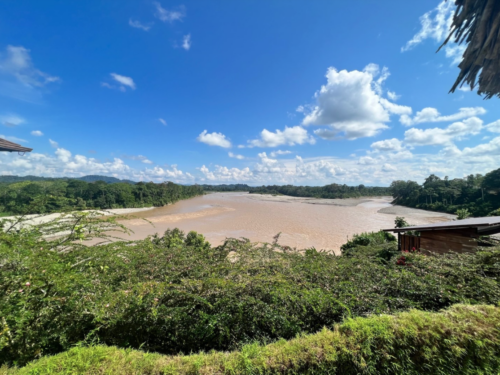
The Napo River, Ecuador. Photo credit: John Fernández
I traveled to Ecuador this past July because I was invited to a gathering to discuss the future of the Amazon with a small and diverse group of scientific experts and academics, financiers, representatives of indigenous people and government leaders. The 2023 Concordia Amazonas Summit was hosted by the former President of Colombia Ivan Duque and was held deep in the Ecuadorian Amazon at a location on the Napo River, Napo Province, Tena Canton. The setting was stunning — a planet away from Cambridge, Massachusetts — and suitably amenable to considering the enormity of both the challenge and the urgency of not further destroying and degrading the forest and waterways of the Amazon.
The gathering included representatives at the highest levels of major conservation organizations including the World Wildlife Fund, Conservation International, World Resources Institute and The Nature Conservancy. The group also included former presidents of Colombia (as mentioned), the former president of Chile Sebastían Piñero and for a day the current president of Ecuador Guillermo Lasso. The group of financiers included an individual who was instrumental in designing and implementing the recent and largest ever debt-for-nature swap with Ecuador, specifically benefiting the Galapagos Islands (Jones and Campos 2023).
The gathering was organized into a series of group discussions, breakout sessions and presentations on the most important factors contributing to the current state and near future of the Amazon. The rights of indigenous people, the production of low and zero carbon energy, technologies for assessing and supporting ecosystems, biodiverse positive infrastructure, financing mechanisms for conservation, sustainable urban planning and population growth in the Amazon were all debated. The conversations were led by individuals with deep expertise in a given subject and engaged in by others approaching the topic with fresh eyes.
I led a discussion on energy production and infrastructure in the Amazon. This is a topic that had first interested me many years before, since I had first noticed the methane-flaring red glow of the night sky of the Colombian Amazon. In fact, energy production in the Amazon — in the most biodiverse region on Earth — is surprisingly extensive. In Ecuador, 91.30% of land-based oil and gas activities are in the Amazon and a study in 2019 determined that more than 10% of the Amazon is involved in oil and gas activities amounting to more than 600,000 km2 (more than 230,000 sq. miles). That’s double the land area of the entire UK.
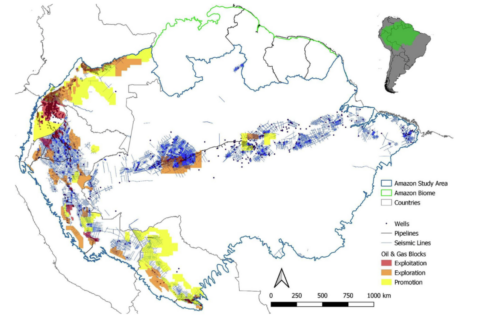
Oil and gas activities in the Amazon. Source: Codato et al. 2019.
This extensive overlap between oil and gas activities and important ecosystems and biodiversity raises a fundamental issue regarding the general intent of leaving reserves untapped as we seek to remain within a global carbon budget. Fossil energy carriers are a commodity, but the biodiversity loss potential of a barrel of oil extracted from the Amazon is very different than one extracted from Saudi Arabian reserves. Yet, once on the global market the embodied biodiversity loss of any particular barrel of oil becomes unknowable — lost in transit and not affecting the price in any way.
Another way to consider this issue is that a barrel of oil left in the ground in Saudi Arabia, or in another relatively less biodiverse place than the Amazon, offers much less potential to reduce biodiversity loss than a barrel of oil left in the ground in the Ecuadorian, or Colombian or Brazilian Amazon.
Of course, the consequences to biodiversity of oil and gas activities around the world is a hotly debated topic with actions being taken to protect important and fragile ecosystems. In the US, the Biden administration recently decided to cancel all drilling leases in the Arctic National Wildlife Refuge and prohibit drilling in 13 million acres of the National Petroleum Reserve. The combined priorities to avoid a “carbon bomb” from the oil extracted, the threat to biodiversity and respect for indigenous values prompted the action.
However, it remains the case today that once a barrel of oil is on the move, the embodied biodiversity loss of that particular barrel is opaque to the market. We discussed the idea of tagging barrels of oil and enacting pricing mechanisms that would reflect the damage done to biodiversity from particular barrels of oil based on their origin. One can imagine the many technological and policy challenges of doing this and yet, if possible, tagging commodity fossil energy carriers with their embodied biodiversity loss may promote appropriate pricing that would effectively limit production and even make prohibitive the cost of oil and gas from sensitive ecosystems around the world. Admittedly, this is a system much easier described than realized beginning with the challenge of replacing the lost revenue to the government from the creation of market friction on oil and gas tagged as high embodied biodiversity loss product.
Also, we heard from several indigenous leaders on the very difficult situation that arises when oil and gas and mining leases are granted on indigenous lands. Despite the fact that many indigenous groups across the Amazon have rights to the land in Formally Recognized Indigenous Territories (FRITs) those rights are often only surface rights, they do not extend to the subsurface which is reserved by the government and therefore can be leased to oil, gas and mining interests. FRITs are extensive, amounting to 26.98% of the Amazon with enormous overlap with gas, oil and mining activities. In a sharp shift away from supporting oil and gas in the Amazon, Ecuadorians recently voted to suspend all development of new oil wells in the Yasuni National Park, one of the most biodiverse territories on Earth and within the ancestral territory of the Huaorani indigenous people (Collyns 2023).
Now, besides oil and gas production for export, imagine that one could provide all the energy needs of the 40 million inhabitants of the Amazon in a manner that achieved net zero emissions? Also, imagine if the public revenue produced by oil and gas production in the most biodiverse region of the world could be replaced by a robust bioeconomy supporting local Amazonian communities and partly financed with international investment aimed at protecting biodiversity and preventing the release of irrecoverable carbon.
These are challenges that MIT can engage in and, from my point of view, must tackle because the entangled polycrises of climate change and biodiversity cannot be ignored for much longer by the major technical research universities of the world, many now fully engaged on climate change. The science is robust in noting that these two challenges are not only intimately connected but should be considered “core” priorities for humanity, co-equal in urgency (Steffen et al. 2015). The ESI is certainly fully committed to expanding work in biodiversity as broadly as we can and involving as many in the MIT community as are interested and willing.
Of course as director of the ESI, I voiced the imperative of science-based decision-making and technology development which must always include the social sciences, design and planning and cultural expertise and engagement in moving forward on enlightened policy for the Amazon.
For example during the session I organized and moderated, I proposed a project in which MIT and others would collaborate to design a decarbonized energy system for a remote settlement in the Amazon of several thousand people. If we can achieve robust technical and economically viable net zero energy systems for a settlement of several thousand — using biodiversity-positive hydroelectric, solar, wind, geothermal and more — we could help to transfer that solution to towns large and small along the many waterways of the Amazon. Doing so would be a fount of innovation, a real-world model of global significance and a rich business space for innovation and entrepreneurship.
In that spirit, a major theme championed by the organizers of the summit was the role of market-driven nature-based solutions to conservation. A lively and well-informed discussion focused on how market-driven mechanisms require careful design and control to avoid unintended effects and runaway dynamics that can lessen, or even nullify positive impacts. After many hours probing the many types of private-public partnerships and other market-driven arrangements it was clear there are already proven financial instruments available to provide funds for effective conservation. One of these was particularly interesting — Project Finance for Permanence (PFP) which involves the creation of a bridge fund to assist governments to incrementally take on the cost of conservation at large scales (Roberts and Lemos de Sá 2023). We also arrived at a consensus that while it is clear the market needs to be engaged in protection of the Amazon, government involvement through oversight, incentives and regulation is critical to achieving real success in protecting biodiversity.
The event ended with a great deal of momentum that we are acting on as I write this. More to come. And now, a bit of a side note on this kind of work…
This trip, and many other efforts at the ESI to promote engagement on issues of biodiversity and climate change are done in a context of complex political factors. Two weeks after I returned to the states, a leading Ecuadorian presidential candidate was assassinated at a rally in Quito — just down the street from the hotel where I had stayed. Six Colombians were detained and, as of this writing, are being held for their alleged involvement in the murder.
Official travel warnings broadcast that Quito is a dangerous place. Same for parts of Colombia, though in our many trips to that country I have never felt unsafe, no more at risk than I feel in any US state that allows the carrying of concealed loaded handguns without a permit. However, it is a sad fact that Colombia is one of the most dangerous countries for environmentalists and Quito’s crime rate is high. Let’s place those facts in perspective.
Ecuador has 2.4 guns per 100 residents and a gun death rate of 6.2 per 100,000. In Quito that rises to 15.57 per 100,000 with a death by firearm every 1 day, 12 hours and 25 minutes. As I have traveled to Latin America these past few years, and brought along undergraduates, graduate students, researchers and other staff of the ESI, I have been concerned with their safety.
However, the US civilian population is the most heavily armed in the world with 120 guns per person and a gun death rate of 10.89 per 100,000 people. The gun death rate in Massachusetts is lowest of all 50 states at 3.4 per 100,000, while more than half of US states exceed the gun death rate of Quito with the top three being New Mexico, Louisiana and Mississippi with 27.8, 29.1 and 33.9, respectively (CDC 2021). To be clear, death by firearm is more likely in more than half of US states than it is in Quito, Ecuador.
There is more nuance to these statistics than I have room for here. For example, these aggregate statistics mask the disproportionate impact on specific communities and income levels, but as we continue to work across the world and in regions with safety concerns — as we expand our engagement on climate change and biodiversity — we should make sure to weigh the benefits against the risks across multiple priorities and contexts. We should also understand the massive social issues that are collocated in places where biodiversity loss and climate change are hitting hardest. This applies as much to doing work in Mississippi as it does to Quito.
J.E. Fernández, Director MIT Environmental Solutions Initiative
September 15, 2022
Cambridge, Massachusetts
References
Assis, T.O. et al. 2020. CO2 emissions from forest degradation in Brazilian Amazon. Environ. Res. Lett. 15 104035. https://doi.org/10.1088/1748-9326/ab9cfc
Boulton, C.A., Lenton, T.M. & N. 2022. Boers Pronounced loss of Amazon rainforest resilience since the early 2000s. Nat. Clim. Chang. 12, 271–278 (2022). https://doi.org/10.1038/s41558-022-01287-8
CDC. 2021. Firearm Mortality by State. National Center for Health Statistics, Centers for Disease Control and Prevention. https://www.cdc.gov/nchs/pressroom/sosmap/firearm_mortality/firearm.htm
Codato, D., Pappalardo, S.E., Diantini, A., Ferrarese, F., Gianoli, F. and M. De Marchi. 2019. Oil production, biodiversity conservation and indigenous territories: Towards geographical criteria for unburnable carbon areas in the Amazon rainforest.
Applied Geography 102, 28-38. https://doi.org/10.1016/j.apgeog.2018.12.001
Collyns, D. 2023. “Ecuadorians vote to halt oil drilling in biodiverse Amazonian national park”. The Guardian, August 21, 2023. https://www.theguardian.com/world/2023/aug/21/ecuador-votes-to-halt-oil-drilling-in-amazonian-biodiversity-hotspot
Jones, M. and R. Campos. 2023. “Ecuador seals record debt-for-nature swap with Galapagos bond”. Reuters, May 9, 2023. https://www.reuters.com/world/americas/ecuador-seals-record-debt-for-nature-swap-with-galapagos-bond-2023-05-09/#:~:text=LONDON%2C%20May%209%20(Reuters),the%20world%27s%20most%20precious%20ecosystems.
Roberts, C. and R. Lemos de Sá. 2023. The innovative climate finance model that has protected over 120 million hectares of ecosystem. Sustainable Finance and Investment, World Economic Forum, July 31, 2023. https://www.weforum.org/agenda/2023/07/climate-finance-pfp/
Will Steffen et al. Planetary boundaries: Guiding human development on a changing planet.Science 347,1259855(2015). https://doi.org/10.1126/science.1259855
